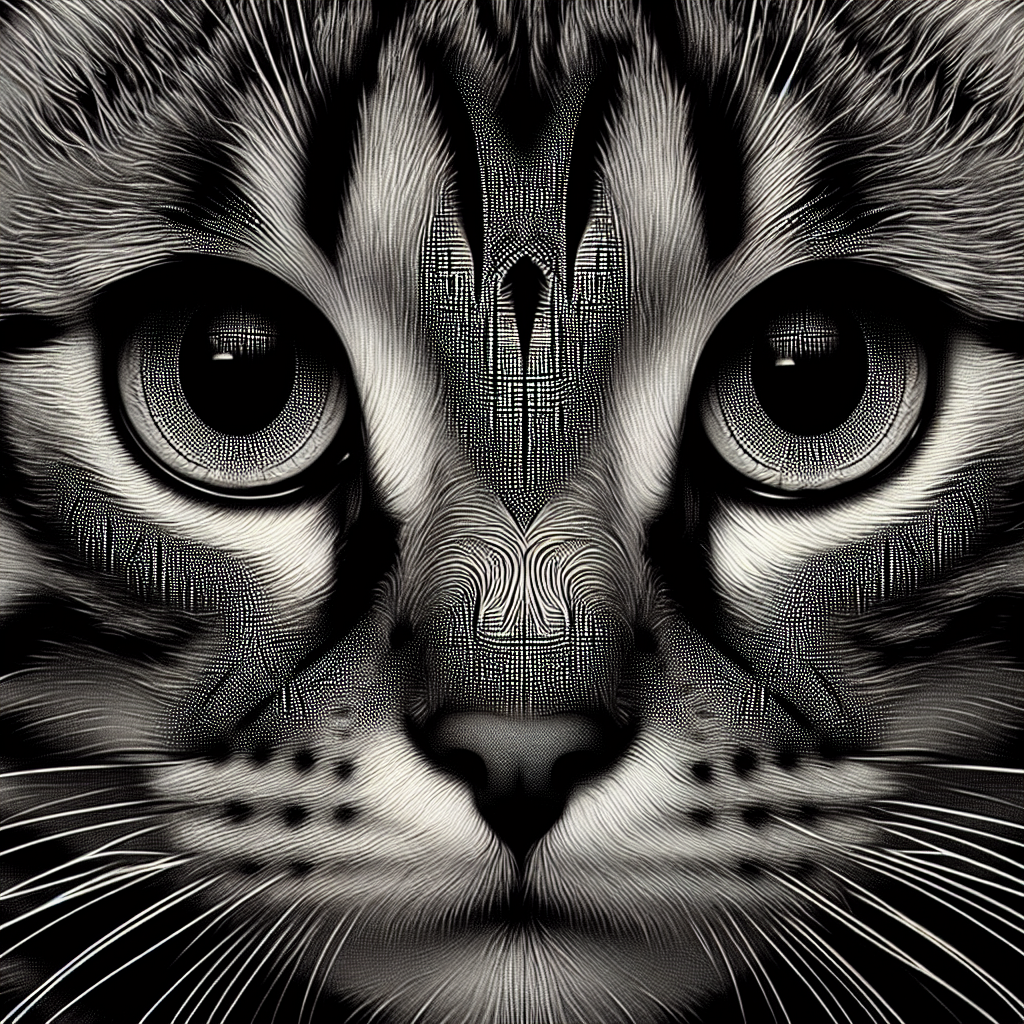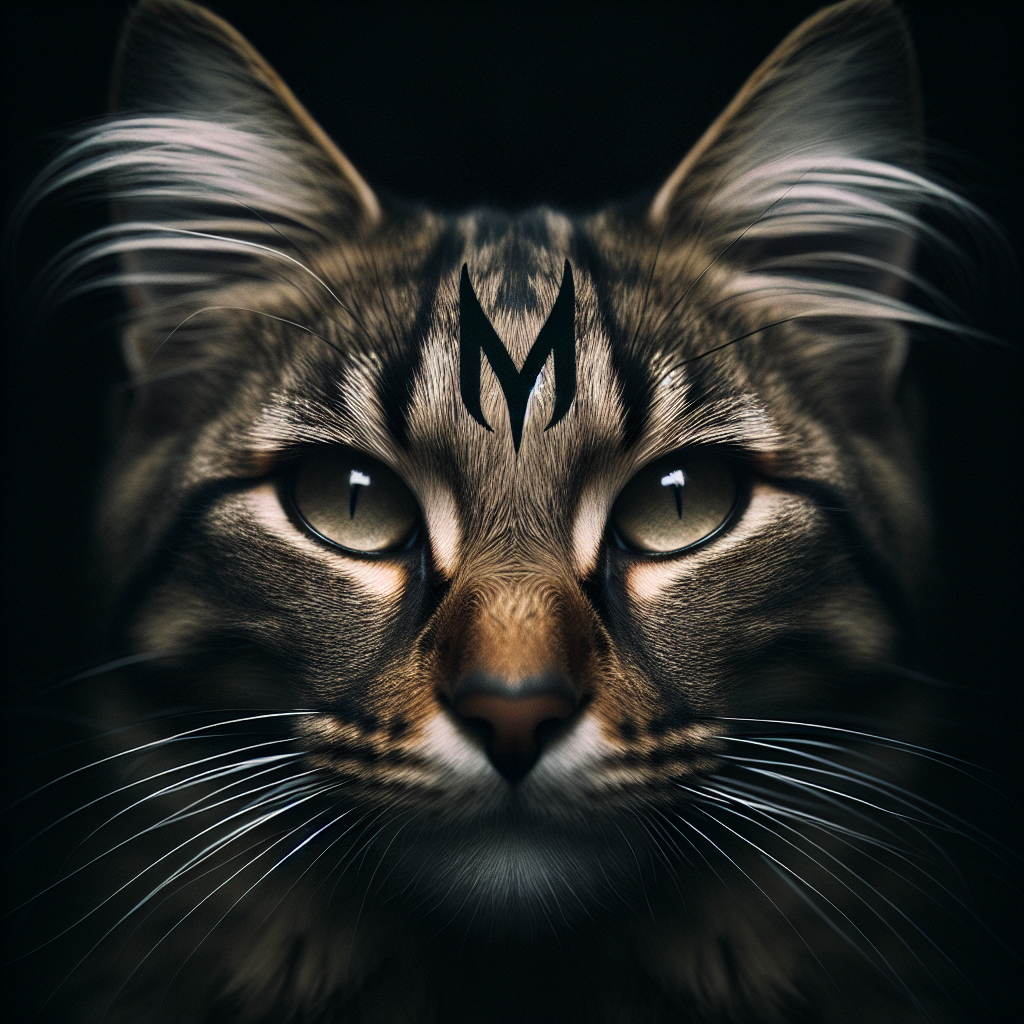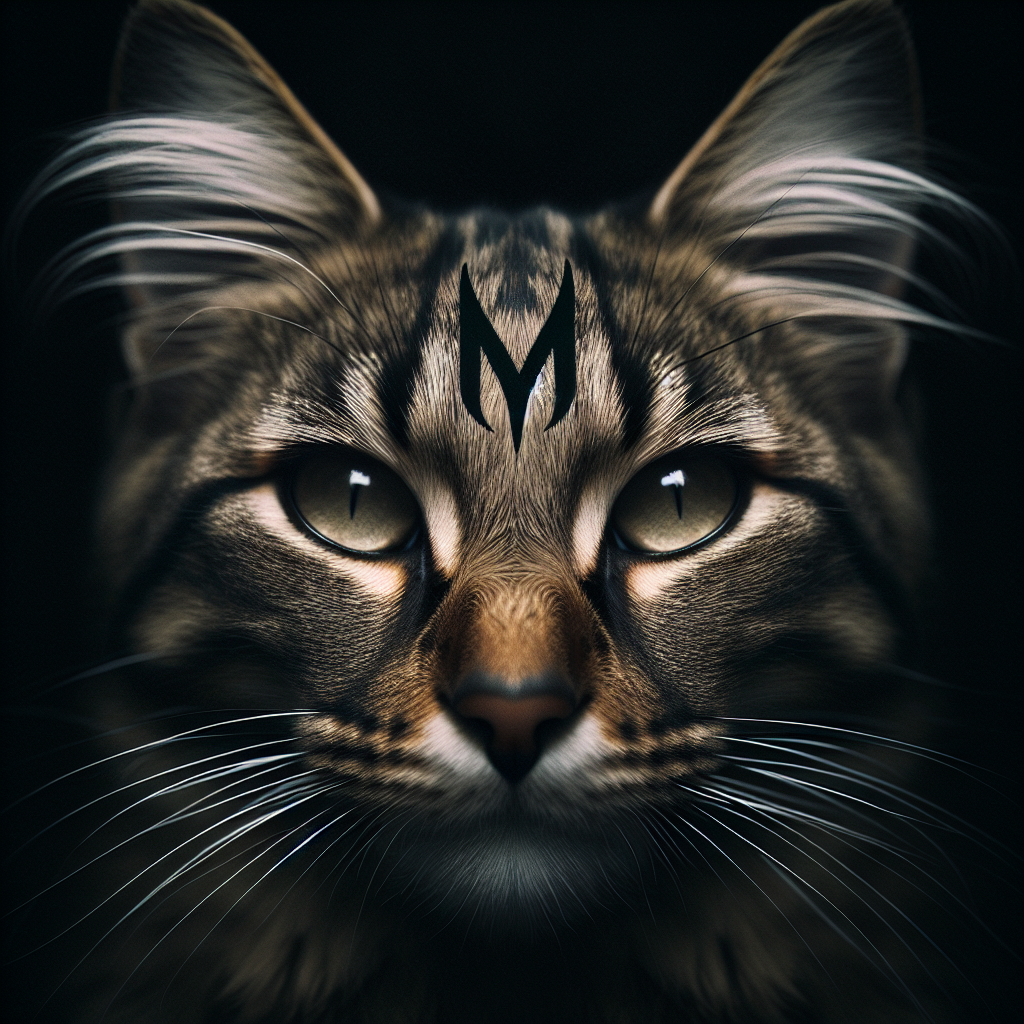Have you ever noticed a distinctive marking on the forehead of a tabby cat? That little ‘M’ shaped marking has intrigued cat lovers for ages, leading to various myths and theories about its meaning. In this article, we will uncover the fascinating truth behind the mysterious ‘M’ on a tabby cat and shed light on its significance. Whether you’re a seasoned cat enthusiast or simply curious about feline mysteries, get ready to unravel the secret of the ‘M’ on a tabby cat.
Physical Characteristics of Tabby Cats
Tabby cats are known for their unique coat patterns, which make them easily recognizable among other feline breeds. These cats typically have a medium to large-sized body with sturdy bone structure. Their legs are proportionate to their body, and their paws are round and compact. Tabby cats have an elegant and expressive face, with large, almond-shaped eyes that come in various colors, such as green, gold, or copper. Their ears are medium-sized and slightly pointed. However, it is their coat patterns that truly set them apart.
Coat Patterns in Tabby Cats
One of the defining features of tabby cats is their beautiful coat patterns. These patterns consist of stripes, swirls, spots, or a combination of these elements. The most common pattern is known as the “mackerel tabby,” characterized by narrow, parallel stripes that run vertically along the cat’s body. Another popular pattern is the “classic tabby,” which displays bold, swirling patterns that resemble a marble-like design. Additionally, there are the “spotted tabby” and “ticked tabby” patterns, which feature distinct spots or individual hairs of different colors, respectively.
Distinctive ‘M’ Marking on Tabby Cats
One of the most fascinating aspects of tabby cats is the presence of an ‘M’ marking on their foreheads. This distinct feature is caused by a dark marking that forms an ‘M’ or an inverted ‘V’ shape between their eyes. This marking can vary in size and prominence among individual cats. It adds an air of mystery and allure to tabby cats, making them even more captivating to observe and admire.
Origins of Tabby Cats
Tabby cats have a rich history that spans across different cultures and time periods. The origins of these remarkable felines can be traced back to ancient times, with several depictions found in various civilizations’ artwork and historical records.
Ancient Egyptian Depictions of Tabby Cats
Egyptian art and hieroglyphs provide us with some of the earliest evidence of tabby cat existence. In ancient Egypt, these cats were highly regarded and considered sacred animals. They were often depicted in murals and sculptures, showing their close association with the divine. The Egyptian belief in the afterlife led them to mummify cats, including tabbies, to accompany their owners on their journey to the next world. The reverence for tabby cats in ancient Egypt showcases their significance in shaping human civilization.
Tabby Cats in Medieval Europe
As the centuries passed, tabby cats made their way to Europe through trade routes and exploration. By the Middle Ages, they became a common sight in medieval households, where they served both practical and symbolic roles. Tabby cats were valued for their ability to keep barns and homes free of rodents, earning them the title of “mousers.” Moreover, tabby cats were often associated with witchcraft and superstitions during this time, being both feared and revered for their mysterious nature.

The ‘M’ Marking and Ancient Legends
The ‘M’ marking on tabby cats’ foreheads has captured the imaginations of many, leading to the development of various legends and myths surrounding its origin and significance. These tales have been passed down through generations, adding an aura of enchantment to these already majestic creatures.
The Legend of the ‘M’ Marking
One popular legend suggests that the ‘M’ marking on tabby cats’ foreheads represents the Goddess of Cats bestowing her mark as a symbol of protection upon them. According to this belief, the Goddess granted tabby cats this emblem to symbolize their connection to the spiritual realm and their role as guardians against evil spirits. Hence, the ‘M’ marking is seen as a spiritual blessing and a sign of good fortune.
The Story of Mau – The Egyptian Cat Goddess
In Egyptian mythology, the cat goddess Mau (also known as Bastet) played a significant role in tabby cats’ association with the ‘M’ marking. Mau was believed to have the power to transform into a lioness or a domestic cat. She was revered as the protector of the pharaoh and was often portrayed with an ‘M’ marking on her forehead. This connection to a goddess further contributed to the belief that tabby cats with an ‘M’ marking were blessed and bestowed with divine qualities.
Scientific Explanations for the ‘M’ Marking
While legends and myths provide captivating explanations for the ‘M’ marking on tabby cats, scientific research offers more grounded explanations rooted in genetics and evolutionary biology.
Genetic Factors in Tabby Cats
The ‘M’ marking is influenced by genetic factors that determine the patterns and colors of a tabby cat’s coat. Researchers have discovered that the ‘M’ marking is a result of specific genes interacting during the cat’s embryonic development. These genes influence the distribution of pigmentation cells, resulting in the formation of the ‘M’ marking.
Role of the Agouti Gene
One particular gene, known as the agouti gene, plays a crucial role in the development of tabby cats’ coat patterns and the ‘M’ marking. This gene regulates the production of pigments in the hair shaft, determining the color and pattern variations seen in tabby cats. The agouti gene’s expression leads to the characteristic striping and spotting patterns found in tabbies, including the formation of the ‘M’ marking on their foreheads.

Variations in Tabby Cats
Tabby cats exhibit a diverse range of coat patterns, reflecting the genetic variations within the breed. Each pattern has its own distinctive charm and allure, adding to the immense beauty and uniqueness of these feline companions.
Mackerel Tabby
The mackerel tabby pattern is one of the most commonly seen coat patterns in tabby cats. It is characterized by narrow, vertical stripes that resemble the bones of a fish, hence the name “mackerel.” These stripes run vertically along the cat’s body and tail, creating a visually striking appearance.
Classic Tabby
The classic tabby pattern is recognized for its swirling patterns and blotches that often resemble a marble-like design. This coat pattern is sometimes referred to as “blotched tabby” due to its distinctively bold markings. The classic tabby pattern showcases a beautiful combination of dark and light colors, resulting in a striking overall appearance.
Spotted Tabby
As the name suggests, the spotted tabby pattern features distinct spots rather than stripes. The spots can vary in shape and size, creating a visually captivating coat pattern. Spotted tabbies often have a wild and exotic appearance, evoking images of their distant feline relatives in the wild.
Ticked Tabby
The ticked tabby pattern is characterized by individual hairs of different colors, creating a subtle and delicate appearance. Instead of specific patterns or markings, the ticking effect gives the cat’s coat a textured and speckled appearance. This coat pattern is often found in Abyssinian cats, adding a unique charm to their refined appearance.
Cultural Significance of Tabby Cats
Throughout history, tabby cats have held a special place in various cultures worldwide. Their unique characteristics and captivating coat patterns have made them subject to folklore, superstitions, and popular culture references.
Tabby Cats in Folklore and Superstitions
Tabby cats have been the subject of numerous folktales and superstitions throughout different cultures. In some cultures, tabby cats are believed to bring good luck and protect against evil spirits. On the other hand, tabbies have been associated with witchcraft and were believed to possess magical powers in medieval Europe. Superstitions regarding tabby cats vary from culture to culture, often highlighting their mysterious and enigmatic nature.
Tabby Cats in Popular Culture
Tabby cats have also made their mark in popular culture. From children’s books to movies and cartoons, these charismatic felines have captured the hearts of many. One iconic tabby cat in popular culture is Garfield, the lovable and lasagna-obsessed cat created by Jim Davis. Garfield’s mischievous and lazy personality, combined with his classic tabby markings, has made him an enduring character loved by millions worldwide.
Tabby Cats as Working Cats
Tabby cats have a long history of serving as working cats, utilizing their natural hunting skills and instincts to assist humans in various settings.
Tabby Cats as Ship’s Cats
During the Age of Exploration, tabby cats were often brought onboard ships as companions and as an essential part of the crew. Their exceptional hunting capabilities helped keep the ship’s hold free of rodents, which posed both hygiene and structural risks. Tabby cats became invaluable members of maritime crews, forging a unique bond with sailors and becoming symbols of luck and protection.
Tabby Cats as Barn Cats
In agricultural settings, tabby cats played a vital role as barn cats, responsible for keeping grain stores and livestock areas free from rodents. Farmers and barn owners recognized the importance of these skilled hunters in controlling the rodent population, ensuring the integrity and cleanliness of their agricultural spaces.
Tabby Cats as Pets
Beyond their historical roles as working cats, tabbies make excellent and beloved companions in domestic settings. Their endearing personality traits and their unique physical characteristics have made them popular choices as pets in countless households.
Personality Traits of Tabby Cats
Tabby cats are known for their friendly and sociable nature, making them ideal companions for families and individuals alike. They are often described as affectionate, curious, and intelligent. Tabbies are known to form strong bonds with their human companions, seeking interaction and snuggling opportunities. They enjoy playtime and are often quite active, making them entertaining and joyful additions to any household.
Caring for a Tabby Cat
Caring for a tabby cat involves providing them with appropriate nutrition, regular veterinary care, and a safe and stimulating environment. It is essential to ensure that they receive a balanced and nutritious diet tailored to their specific needs. Regular vet check-ups, vaccinations, and preventive care, such as flea and tick treatments, are crucial for their overall health and well-being. Furthermore, creating a stimulating and enriching living space for tabbies, including interactive toys and scratching posts, helps keep them mentally and physically stimulated.
The ‘M’ Marking in Other Animals
While the ‘M’ marking is commonly associated with tabby cats, similar markings can also be found in other animal species, raising intriguing questions about its significance in the animal kingdom.
Examples of ‘M’ Marking in Other Species
Besides tabby cats, several species in the animal world display markings similar to the ‘M’ pattern. For instance, some dog breeds, such as the Jack Russell Terrier and the German Pinscher, may exhibit an ‘M’ marking on their forehead. Additionally, some wild felids, like the Eurasian lynx and the cougar, may also have this distinctive marking.
Possible Explanations for the ‘M’ Marking
The presence of the ‘M’ marking in other animal species suggests the possibility of shared genetic factors or evolutionary convergences. It remains an intriguing area of study for scientists and researchers, as they delve deeper into understanding the origins and biological significance of this unique marking.
Conclusion
Tabby cats are an enchanting and captivating breed, with their distinctive coat patterns and the iconic ‘M’ marking on their foreheads. Throughout history, tabbies have held significant cultural and practical roles, evolving alongside human civilization. From ancient Egyptian depictions to medieval European folklore, these cats have been revered, feared, and celebrated. As pets, tabby cats offer their unique personalities, making them cherished companions in countless households worldwide. While the origins and significance of the ‘M’ marking continue to be explored through scientific research and ancient legends, one thing remains certain: tabby cats, with their charm, grace, and endearing ‘M’ marking, have gracefully earned their place in both history and our hearts.

